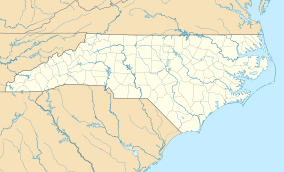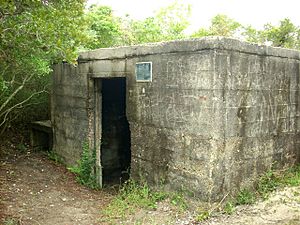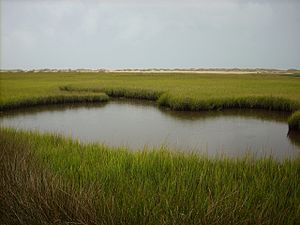Fort Fisher State Recreation Area facts for kids
Quick facts for kids Fort Fisher State Recreation Area |
|
|---|---|
 |
|
| Location | New Hanover, North Carolina, United States |
| Area | 287 acres (116 ha) |
| Established | 1986 |
| Named for | Fort Fisher |
| Operator | North Carolina Division of Parks and Recreation |
| Website | Fort Fisher State Recreation Area |
Fort Fisher State Recreation Area is a 287-acre (1.16 km2) state park in New Hanover County, North Carolina. It's located near Kure Beach, North Carolina. This special place includes the historic Fort Fisher, which was important during the American Civil War.
The recreation area also has a long stretch of beach. This beach is a vital nesting spot for sea turtles. Park rangers carefully watch for new turtle nests. When they find a nest, they mark it and put up a mesh fence. This fence keeps vehicles from driving over the eggs. The mesh has openings big enough for baby turtles to crawl through and reach the ocean.
You can visit the remains of the old earthen fort and a museum at the Fort Fisher State Historic Site. There's also an oceanfront beach pavilion. A large lagoon is popular for windsurfing. Some parts of the beach can only be reached by four-wheel-drive vehicles.
Contents
Fort Fisher's Past: A Civil War Story
The city of Wilmington was a very important port for the Confederacy during the Civil War. By late 1864, it was the last southern port still open for trade. Fort Fisher was built in 1861 to protect this valuable port from Union ships.
In 1864, Union forces attacked Fort Fisher for the first time. The fort was strong, and the Union soldiers had to retreat. But the Confederacy wasn't as lucky the next time. The First Battle of Fort Fisher was one of the biggest naval attacks and land-sea battles ever fought at that time.
In early 1865, a huge fleet of 56 ships bombed the fort. Then, more than 3,300 soldiers attacked by land. Fort Fisher was captured, and the Confederacy's supply line was broken. About three months after Fort Fisher fell, the Civil War ended.
The Rocks and The Basin
In the late 1800s, a long rock wall called "The Rocks" was built west of Fort Fisher. It helped ships navigate the Cape Fear River by stopping sand from building up. Finished in 1881, The Rocks closed off an old inlet. This inlet was once used by Confederate ships to avoid the U.S. Navy.
Closing the inlet created a lagoon, which is now called "The Basin." Today, The Rocks and The Basin are part of the Zeke's Island area. This area is a special 1,160-acre (4.7 km2) reserve. It has amazing marshes and tidal flats, which are important for ocean life.
Fort Fisher in Modern Times
During World War II, concrete forts were built along the North Carolina coast. A grass landing strip was made through the old fort's earthworks. This strip was used to resupply planes that patrolled the coast.
The Fort Fisher visitor center was built in the middle of this landing strip. The north end of the strip was paved for the visitor center's parking lot. You can still see the outline of the original landing strip, especially from aerial photos.
Protecting the Coastline
Throughout the 1980s and 1990s, the beach near the fort slowly wore away due to beach erosion. Much of the Civil War-era fort was lost to the sea. In 1999, work began on a large seawall to protect the fort from further erosion.
Building the seawall was a bit controversial. Some people worried it might cause erosion in other parts of the beach. However, it was finished in 2000 and successfully stopped erosion in the fort area.
The Fort Fisher Hermit
The recreation area was also home to a unique person known as the Fort Fisher Hermit, Robert Harrill. He lived in a bunker and shared his ideas about "common sense" with many visitors. He survived by finding food in the nearby salt marsh and oyster beds.
| Preceded by Kure Beach |
Beaches of Southeastern North Carolina |
Succeeded by Zeke's Island |




